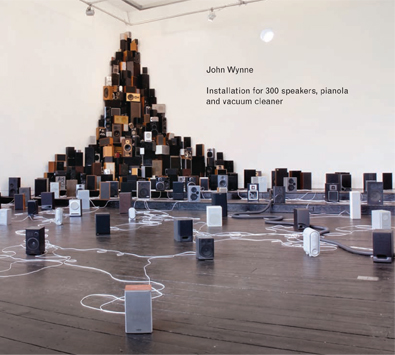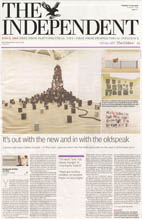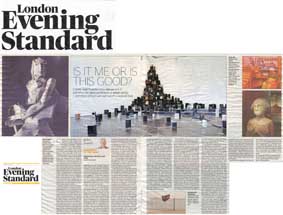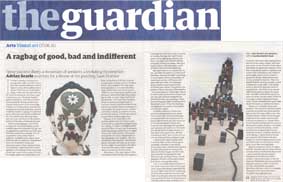|
||
Such a gathering of sonic elements seems to seek out points of not only conjunction, |
||
John Wynne’s Installation for 300 speakers, player piano and vacuum cleaner is at once monumental, minimal and immersive. It uses sound and sculptural assemblage to explore and define architectural space and to investigate the borders between sound and music. The piece has three interwoven sonic elements: the ambient sound of the space in which it is installed, the notes played by the piano, and a computer-controlled soundtrack consisting of synthetic sounds and gently manipulated notes from the piano itself. Because none of these elements are synchronised with each other, the composition will never repeat. The music punched into the paper roll is Franz Léhar’s 1909 operetta Gypsy Love, but the mechanism has been altered to play at a very slow tempo and the Pianola modified to play only the notes which most excite the resonant frequencies of the gallery space in which it is installed. Sound moves through the space on trajectories programmed using a 32-channel sound controller, creating a kind of epic, abstract 3-D opera in slow motion. Originally developed during Wynne's Soundtrap Residency at Beaconsfield Gallery, a former Victorian ‘ragged school’ in South London, this piece draws on notions of obsolescence and nostalgia, combining early 20th century technology and culture with a vast collection of discarded hi-fi speakers found on the streets of London and Berlin and in recycling depots in both cities. These disparate components are brought together through contemporary digital technology which not only distributes the sound but also controls the (found) vacuum cleaner which in turn drives the Pianola. The piece is site-specific, but it also carries traces of its own history: some of the synthetic sounds were created in response to the light industrial ambience of the work’s original location, some in response to its new site in the Saatchi Gallery. The mountainous formation of speakers, inspired by the recycling plant from which some of the speakers were rescued, functions both visually and as a platform for the projection of sound, creating, in the words of writer Brandon LaBelle, ‘a soft balance between order and chaos, organization and its rupture’. |
||
|
Saatchi Gallery, 2010 (Photos by Tim Wainwright) |
|
|
||
|
||
|
|
||
|
||
|
||
_____________________________________________________________________________________________ |
||
 |
Thanks to Rex Lawson of the Pianola Institute, Scott George of Autograph Sound, Tim Bartoo of Harmonic Functions, |




